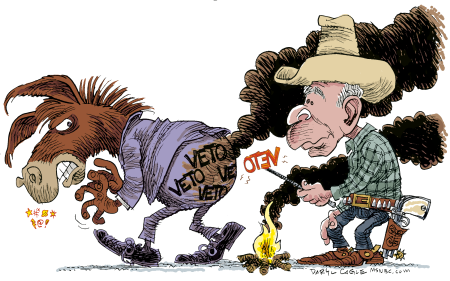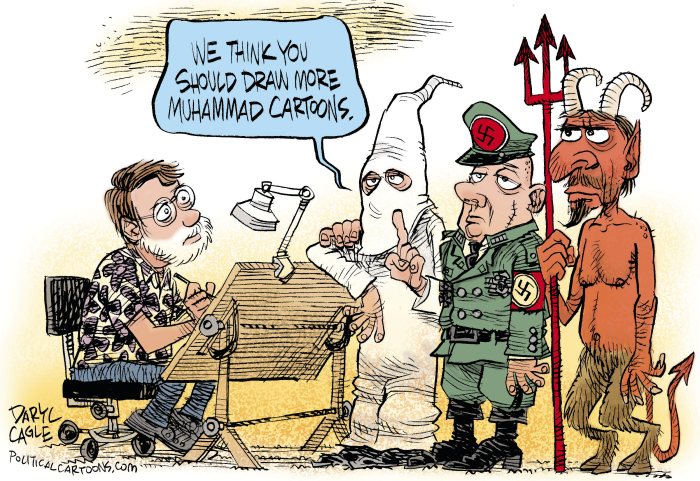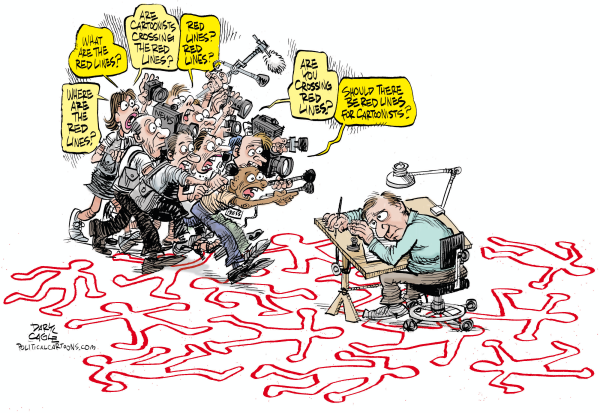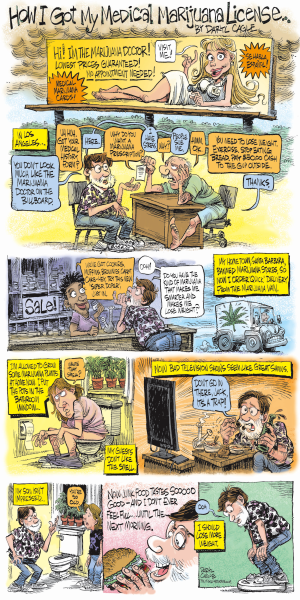
How to Draw President George W. Bush
Political cartoonists are not much different from comic strip cartoonists; both draw an ongoing daily soap opera featuring a regular cast of characters. While comic strip cartoonists invent their own characters, the political cartoonist’s characters are given to him by events in the world. For the past eight years, political cartoonists have been drawing little daily sagas starring the same main character, President Bush. Most people won’t miss Bush as a president, but we should all miss him as a great cartoon character.
Around the world, cartoonists almost always draw President Bush as a cowboy. Outside America, a Texas cowboy is seen as: uneducated, ill mannered, a “trigger-happy marshal” or outlaw who is prone to violence. Cowboy depictions of the president by worldwide cartoonists are meant to be insults, but Americans see cowboys differently. In the USA, cowboys are noble, independent souls, living a romantic lifestyle by taming the wilderness and taking matters into their own hands whenever they see a wrong that needs to be righted. We are a nation of wanna-be cowboys.
The image of President Bush evolves with each cartoonist’s personal perspective. Back in 2000, Bush started out as most political cartoon characters start out, as a caricature of a real person, meant to be recognizable from a photograph. The cartoonists soon stopped looking at photographs and started doing drawings of drawings, then drawings of drawings of drawings, so that the George W. Bush drawings morphed into strangely deformed characters that looked nothing like the real man, but are instantly recognizable because we’ve come to know the drawings as a symbol of the man. It is surprising that each cartoonist’s drawings of the president look entirely different, but each is easily recognizable as representing the same character.
For most cartoonists, the president’s ears have grown huge; a strange phenomenon, since the president doesn’t have unusually large ears, and isn’t well known for listening. Some cartoonists have seen President Bush shrink in height; a combination of these has the president sometimes looking like a little bunny rabbit. Barack Obama’s cartoon ears have also begun to grow in cartoons, for no good reason – maybe big ears are the cartoon presidential curse of the new millennium.
The president who shrank most in cartoons was Jimmy Carter. At the end of Carter’s term he was a Munchkin, standing below knee height on almost every cartoonist’s drawing table. President Bush shrank for only the more liberal cartoonists early on, but is short for all of us at the end of his term. President Reagan grew taller during his cartoon term in office. President Clinton grew fatter, even as he lost weight in real life. Bill Clinton’s personality was fat, and the cartoonists drew the personality rather than the man. President Clinton is now skinny, but he will always be fat in cartoons.
Another cartoon characteristic that has grown from years of drawing President Bush are his eyes, two little dots, close together, topped by raised, quizzical eyebrows. The close, dotted eyes are an interesting universal phenomenon, shared by almost every cartoonist, that doesn’t relate to the president’s actual features. Over time, most cartoonists will draw a character with eyes that grow larger, but President Bush’s eyes shrink, while his ears grow. There may be a political message in that, but I can’t figure it out.
I once played “Political Cartoonist Name That Tune.” The game went like this:
“I can draw President Bush in SIX LINES.”
“Well, I can draw President Bush in FOUR LINES!”
“I can draw President Bush in THREE LINES!”
“OK. Draw that President!”
…and I did, two little dots topped by a raised, quizzical eyebrow line. It looked just like him.
Now I need to learn how to draw Obama with three lines; it may take me eight years to do it.
Daryl Cagle is a political cartoonist and blogger for MSNBC.com; he is a past president of the National Cartoonists Society and his cartoons are syndicated to more than 850 newspapers, including the paper you are reading. Daryl runs the most popular cartoon site on the Web at www.cagle.msnbc.com. His books “The BIG Book of Campaign 2008 Political Cartoons” and “The Best Political Cartoons of the Year, 2009 Edition” are available in bookstores now.
See Daryl’s cartoons and columns at http://blog.cagle.com/daryl.















